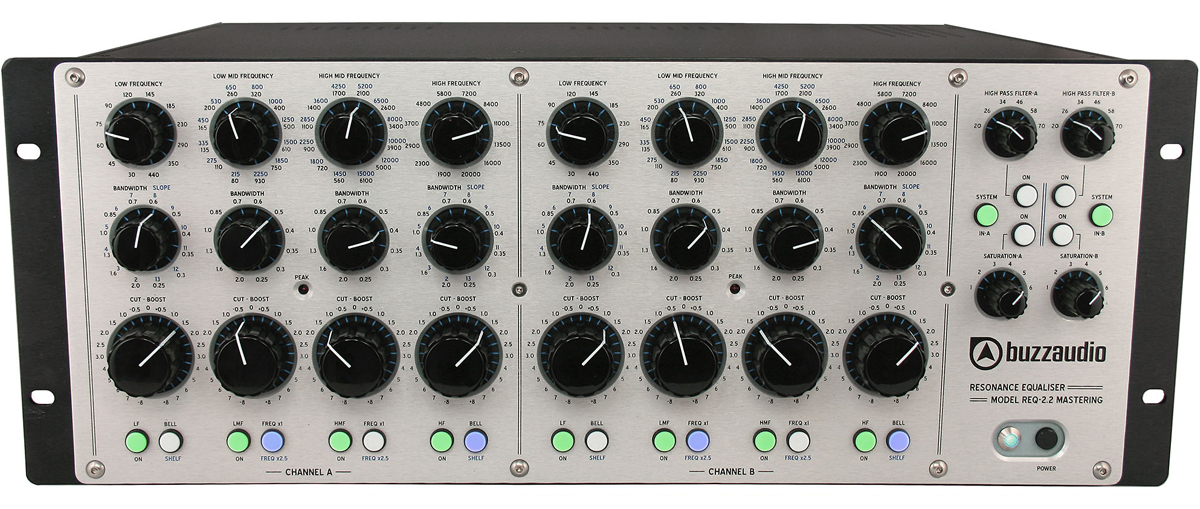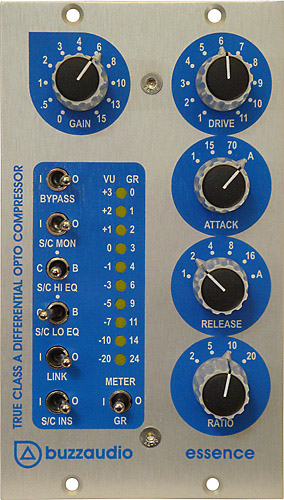
Add some real vibe to your mastering project with our take on the vintage diode bridge compressor technique.
Audio Path Color
The DBC-M is a Mastering version of the popular Buzz Audio DBC-20 diode bridge compressor and offers fully switched control for repeatable settings. The diode bridge gain reduction element coupled with our innovative side chain design delivers a vintage vibe like no other. The DBC-M audio path uses our Class A discrete amplifier designs in a balanced configuration from input to output with a radio steel laminated transformer to couple into the diode bridge element. This overall combination produces a desirable compression character that can best be described as tight, colourful and rich with harmonics.
Dynamic Ratio Power
In the style of compressors from the 60's, the DBC-M incorporates a automatic ratio whereby the compression ratio is progressively increased with deepening gain reduction. This feature allows for the control of very dynamic signals in a seamless fashion and is also a very desirable characteristic when used on complex percussive material.
Operational Ease
This compressor is easy to get happening with six switched attack and release times covering a wide range, including an interesting auto release mode. Big knobs with 24 position stepped Elma controls are provided for the amount of compression and the output gain. The compressor can be switched to a Soft mode whereby dynamic peaks are partially retained and another switch introduces a high pass filter to the side chain to lower compression sensitivity at low frequencies. The attractive "point source" red LED bar graph meter accurately displays gain reduction and the gloss finish knobs adds to the vintage feel of the DBC-M.
Controls and Functions
GAIN - 24 position Elma switch that adds gain at the output to correct for lost level with a -2.0 to +10dB range in 0.5dB steps.
COMPRESSION - 24 position Elma switch that sets the amount of compression.
ATTACK - rotary switch with 6 settings, FAST (less than 0.5mS)-5mS-10mS-15mS-25mS-50mS.
RELEASE - rotary switch with 6 recovery time settings, 50mS-100mS-200mS-400mS-600mS and AUTO.
HARD/SOFT - adds dynamics in soft mode for times when very light compression is required.
FLAT/BASS - reduces compression sensitivity at low frequencies for more bass punch.
BYPASS/ENGAGE - hard wire unit bypass to compare compressed and uncompressed signals.
There is also a handy power ON/OFF switch and the LINK A/B which provides for stereo tracking to prevent image shift when used on the mix buss.
Specifications
Maximum Input Level; +27dBu
Maximum Output Level; +27dBu
Noise; -80dBu (measured A Weighted with 10dB gain applied)
Gain; variable -2.0 to +10dB in 0.5 dB steps
Frequency Response; 6Hz to 400kHz measured no gain reduction
Harmonic Distortion; At +10dBu input level, no gain reduction; 0.28% @ 100Hz, 0.25% @ 1kHz, 0.15% @ 10kHz
Harmonic Distortion; With 10dB gain reduction (Release set to 400mS); 1.5% @ 100Hz, 0.5% @ 1kHz, 0.5% @ 10kHz
Standard Operating Level; +4dBu
Size; 1 Unit 19" rack mount, (482Wx44Hx250D)
Power requirements; 230V/115V selectable, IEC detachable power cable.
Specifications are typical of a production unit and are subject to change without notice.
0dBu reference = 0.775 volts RMS.












